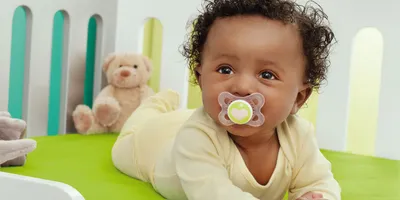Todos/as los/as niños/as tienen la necesidad de mamar para calmarse, incluso antes de nacer. Los chupetes pueden jugar un papel importante aquí y satisfacer la necesidad de chupar. Dependiendo de la edad, el chupete asume ciertas funciones. Aquí puedes saber cómo y cuándo se puede utilizar mejor el chupete y cuándo es el momento de retirarlo gradualmente.
Los/as bebés tienen una fuerte necesidad de succión. A partir de la semana 14 de embarazo, aproximadamente, se puede observar cómo se chupan los dedos mediante una ecografía.
Los/as bebés chupan cuando tienen hambre para consolarse o distraerse. Sobre todo en el primer año de vida, el chupete puede ser una ayuda útil para satisfacer la enorme necesidad de succión.
A medida que el/la niño/a crece, encuentra nuevas formas de calmarse sin chupete y de enfrentarse a situaciones frustrantes.
Los padres y madres y los/as niños/as suelen encontrar estresante el destete del chupete. En muchos casos, es el primer problema en la relación entre los padres y el/la niño/a hay que establecer los límites una y otra vez y se espera que el/la niño/a dé pasos en su desarrollo.
Hemos resumido para ti toda la información importante sobre el chupete y su función:
Función del chupete
Dependiendo de la edad del/de la niño/a, el chupete cumple diferentes funciones.
En los primeros meses de vida, chupar un chupete satisface la necesidad de succión y tiene un efecto tranquilizador. A medida que los/as niños/as crecen, encuentran otras maneras de reconfortarse y distraerse.
¿Por qué necesita el/la niño/a el chupete?
En el primer año de vida:
- Satisface la necesidad de chupar
- Tiene un efecto calmante y reconfortante
- Ayuda a aliviar la tensión
- Es una medida preventiva recomendada contra el síndrome de muerte súbita del lactante
En el segundo y tercer año de vida:
- Ayuda al/a la niño/a a tranquilizarse
- Ayuda a aliviar la tensión
- Puede actuar como "acompañante" para apoyar la independencia del/de la niño/a
Managing pacifiers use - the parents’ role
In the 1st year of life
- Use a pacifier to help comfort the child
- At the same time, start to develop other ways of comforting the child (e.g. relaxation through toys, music, physical presence)
- Use pacifiers to provide comfort in specific situations
- Reduce the availability of the pacifier
- Start asking the child to remove the pacifier, for example, when speaking
- Only use the pacifier in exceptional situations (e.g. moving house, new family situations)
- Encourage and use other methods to comfort the child




























